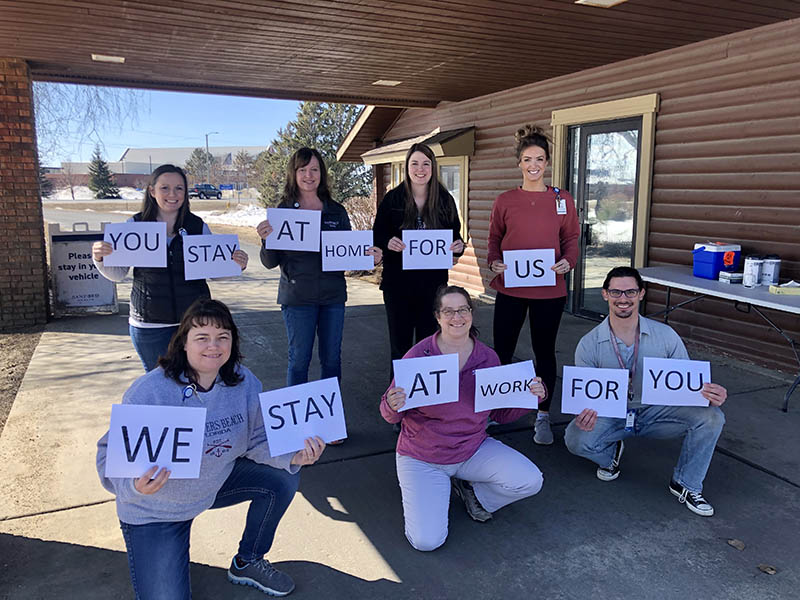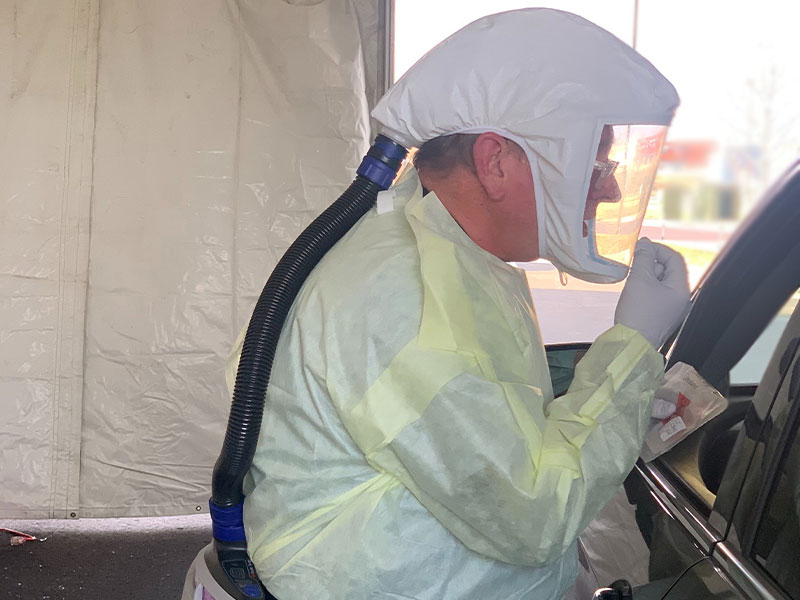Earlier this month, Sanford Health decided a drive-thru-like COVID-19 testing location and clinic was needed in Sioux Falls, South Dakota.
In less than 24 hours, both opened.
Testing team effort
This site, which averages 70 to 90 tests per day, couldn’t have been set up without the leadership of Dr. Brian Tjarks and his team.
“I can’t take all the credit. It was amazing how fast our team got drive-thru testing established. From when we first decided we were going to do this, to having it up and running for patients, it was 23 hours. Less than a day,” said the urgent care physician.
How testing would operate in Sioux Falls was decided by a team of 15.
“I don’t know of any other place where you can get a team together who works together like we have. Everyone has a can-do attitude. There was no negative attitudes.”
Dr. Tjarks and his team had to start from scratch, by first picking a location.
“We had to come up with a site that would work. We had to set up protocol. Everyone weighed in. It was just an amazing way that everyone worked together. Everyone was positive. It all came together and has worked really well,” said Dr. Tjarks.
Learn more: Who gets a coronavirus test?
Sanford Health has since opened additional drive-up testing sites in Aberdeen, South Dakota; Fargo and Bismarck, North Dakota; and Bemidji, Minnesota. Sanford Health will not give out the exact location of its alternate collection sites to prevent overcrowding. Tests are reserved for patients who have received an order for a test from a Sanford doctor.
Other parts of the country have had similar sites shut down, because patients who weren’t given a doctor’s order for the test had overrun those locations.
This is why calling ahead of time and receiving a testing order from a doctor is critical, according to Dr. Tjarks.
“We’re encouraging electronic visits, or video visits. Call your doctor, so that they can order and schedule your tests ahead of time,” said Dr. Tjarks.
How it works

Photo by Sanford Health
After receiving a doctor’s order for a test, patients drive up to the first tent. Nurses verify patient information, including verification of a testing order.
“We make sure there’s an order for testing. A nurse puts a mask on the patient, gives them a packet of information, and a letter for work,” according to Dr. Tjarks.
Dr. Tjarks discourages patients from coming with any passengers in the car with them.
“We’ve got to slow the spread as much as possible. It’s a responsibility for everyone,” he said.
From there, patients drive to a second tent. If they feel comfortable doing the testing from their car, Dr. Tjarks and his team will conduct nasal swab tests.
“The whole process takes under two minutes,” he said.
There are some instances were patients need to be seen, which is where the clinic comes into play.
“If they need to be seen, they’ll be seen in the clinic. The providers can put a note in the order saying the patient needs to be evaluated. Our goal is to prevent the spread of the virus. That’s part of the reason we’re trying to keep as much testing outside of the clinics as we can.
“We have 10, 11 exam rooms. We’re set up to evaluate patients if they need to be evaluated if they come through the drive-thru, or if they come to the clinic to be seen.”
Alternate collection sites are operating across Sanford’s footprint.
Dr. Tjarks’ message to you
Dr. Tjarks says through teamwork the virus “will be conquered.” However, everyone plays a part.
“The only way we know how to stop this virus is for people to practice social isolation and social distancing,” he said. “Good hand hygiene, avoid touching your face, and not going to areas of large crowds. That’s the only way we know that we can stop this virus.”
In addition, Dr. Tjarks says it’s important to note the difference between social isolation and social distancing.
“Those practices of hand hygiene and six feet of distance between you and another person, that’s social distancing. Patients we’re testing need to be isolated. That means having their own bedroom and bathroom in the house, avoiding contact with people, even in their own families.”
Learn more
- Sanford Health launches in-house testing for coronavirus
- COVID-19 FAQs: How can I tell if I have coronavirus?
- COVID-19 FAQs: What is social distancing?
…
Posted In Aberdeen, Bemidji, Bismarck, COVID-19, Fargo, Physicians and APPs, Sanford Stories, Sioux Falls
